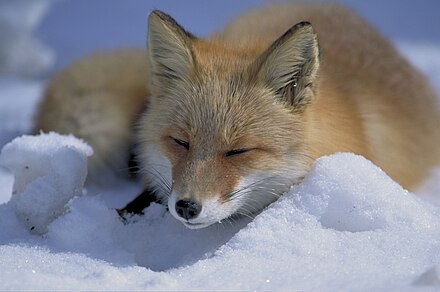Foxes are small to medium-sized carnivorous mammals belonging to the Canidae family. In the Canidae family, the genus Vulpes contains a variety of different fox species, the most famous of which may be the red fox (Vulpes vulpes), also known as the red fox. There are many different species of foxes found in a variety of habitats around the world, from the tundra of the Arctic to the deserts of Africa and the forests of Asia.

Size and weight: The body size of foxes varies depending on the species. The weight is generally between 3.6 and 7 kg, the body length (excluding tail) is about 40 to 83 cm, and the tail length can reach 30 to 55.5 cm.
Appearance: Foxes typically have a slender body, pointed ears, a slightly raised tail, and a sharp face. Their coat colors vary, with red, gray and light brown being common.
Senses: Foxes have very keen hearing and can hear the movements of small animals underground. Their senses of smell and vision are also well developed.
Food habits: Foxes are omnivores, and their food includes small mammals, such as rats and rabbits, as well as birds, insects, worms, fruits and vegetables.
Habitat: Different species of foxes have adapted to a variety of habitats, including forests, grasslands, mountains, deserts, and cold arctic regions.
Behavior: Foxes are primarily nocturnal, but they can be seen during the day in some areas and seasons.
Sociality: Although foxes are usually known as solitary animals, they actually form small family groups, especially during the breeding season.
Breeding Season: Foxes breed once a year, usually between late winter and early spring.
Reproduction: The gestation period of a female fox is about 52 days, and each litter usually gives birth to 4-6 cubs.
Raising cubs: After birth, the cubs are cared for and fed by their mother. They leave the nest when they are about 10 weeks old and begin to learn hunting skills.
Some fox populations may be threatened in specific areas due to habitat loss, hunting and disease.
Foxes are natural predators that play an important role in controlling rodent and other agricultural pest populations, but in some places they are also considered a threat to poultry and wildlife populations.
Foxes are often associated with wisdom and cunning in various cultures.
Foxes were once widely hunted in the fashion industry for their fur, although hunting has been curtailed or banned in some places due to legal or ethical concerns.
Foxes play an important role in the ecosystem as predators, helping to keep many small animal populations in balance. At the same time, they also facilitate the flow of energy in the food chain and the circulation of materials in the ecosystem. Protecting foxes helps maintain the overall health of the ecosystems in which they live.
animal tags: fox
We created this article in conjunction with AI technology, then made sure it was fact-checked and edited by a Animals Top editor.